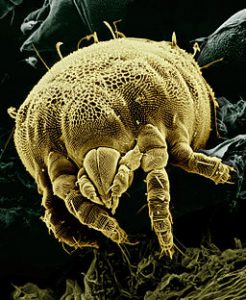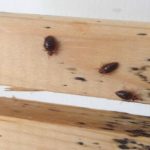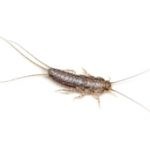Bed Bugs or Dust Mites – What Bit You?
Waking up with red, itching spots can be aggravating, and many people wonder if dust mites or bed bugs are to blame. They both enjoy spending time in your bedding and furniture, yet they affect people very differently. Knowing how to distinguish them from the bites, symptoms, and other signals can make all the difference in getting the right treatment and keeping the pests out of your home for good.
Dust Mites vs Bed Bugs
Dust mites and bed bugs are often confused because they both infest bedding and furniture, but they are very different in terms of appearance, behaviour, and impact on humans.
Do Dust Mites Bite Like Bed Bugs?
No, dust mites do not bite like bed bugs.
And to be more specific, we can say that dust mites DON’T bite. They can’t. Dust mites don’t have teeth or a mouth to bite you with. It is not dust mites bites that you get allergic reactions from. It’s from their faeces and a protein from their bodies that you breathe in that causes health problems.
Bed Bugs

Size: Up to 5mm. Can be seen with a naked eye.
Diet: Feeds on your blood. Bites you at night while you sleep.
Habitat: Lives near your bed. It may be in your mattress or spring box.
Health hazard: Does not transmit diseases but allergic people can have a reaction to their bites.
Visible to the human eye: Bed bugs can be seen with the naked eye. They are just very small.
Read more: Bugs that Look Like Bed Bugs
Dust Mites

Size: Up to 0.5mm. Microscopic creatures that you’ll never be able to see with a naked eye.
Diet: They feed on house dust and your dead skin cells. And your pet’s dead skin cells.
Habitat: They can live in your mattress, upholstered furniture, or carpet.
Health hazard: Not a direct thread. They don’t bite people. Problems may occur when you breathe in their dried faecal matter and a protein from their body parts and they get in your lungs and irritate them, which may cause asthmatic symptoms.
Visible to the naked eye: No, you cannot see dust mites with a naked eye.
Are Bed Bugs or Dust Mites Parasites?
First of all, what is a parasite? The definition states that this is an organism that lives and benefits from another organism at its expense. Parasites can use the other organism for shelter, food, and for reproduction. Either way, the parasite needs a host to survive.
Bed bugs fit the definition of parasites. They do not stay attached to the host, but live near it and feed on the host’s blood at regular intervals.
Dust mites, however, do not fit the definition. They do not need a host to survive and feed on. Dust mites are incapable of biting people or animals. They feed on the dead skin cells we all shed, but they do not have direct contact with another organism.
Symptoms of Bed Bug Bites vs Dust Mite Allergies
Bed Bugs Bites
Bed bugs will bite you and not only once. They feed on you every couple of days. Rarely do they cause major health problems but to people susceptible to allergies they can have some influence and cause skin irritations, blisters, asthma or other breathing problems.
More often you will notice red welts but they can appear days after the biting. With bed bug bites the symptoms and problems differ from person to person. Some people don’t even show symptoms or have welts.
You may not feel the bed bugs biting you but you will feel the bite marks when and if they appear. The bed bug bites will be itchy but you should avoid scratching them as much as you can. If you scratch the itchy bed bug bites or skin eczema caused by an allergic reaction to dust mites, they may turn into scars. But if you leave them be and go away on their own, you won’t have problems with scars.
If the welts look like they are in a line, a cluster or some kind of a pattern, then you have bed bug bites.
Check also: Biting and Stinging Insects in the UK
Dust Mite Allergic Reactions
If you are experiencing a dust mite allergy, the symptoms to be aware of are skin eczema, dermatitis, and rarely hives or rashes. You can also have a runny or stuffy nose, cough, sneeze a lot, or have difficulty breathing or asthma.
If you are not allergic to bug bites or dust mites, the bite marks and skin problems should go away on their own in a couple of weeks.
In need of professional bed bugs service?
Book a bed bugs exterminator and get high-quality results.
What To Do In Case You Have an Allergic Reaction to Dust Mites?
 Neither bed bugs nor dust mites transmit diseases to people. However, they can cause a number of serious health problems to people with allergies.
Neither bed bugs nor dust mites transmit diseases to people. However, they can cause a number of serious health problems to people with allergies.
You should also avoid dust and dust mites especially if you are pregnant. A study shows that if dust mite remnants get into the mother’s organism they may reach the baby and increase the risk of the baby developing an allergy.
The symptoms can be mild to severe. If the symptoms are mild and go on for more than a week, visit your doctor to determine if it is a dust mite allergy or a regular cold.
Mild Symptoms of Dust Mite Allergy
- Runny or stuffy nose. Which gets worse in the mornings and evenings.
- Watery or red eyes.
- Nasal congestion or postnasal drip.
- Coughing or sneezing.
- Rarely skin redness or hives.
Severe Problems of Dust Mite Allergy
These symptoms are more likely to occur in people who already have asthma or allergies to dust mites.
- Difficulty breathing
- Severe asthma attacks
- Pain or tightness in the chest
- Shortness of breath
- Wheezing or whistling while exhaling
Risk Factors for Developing a Dust Mite Allergy
- Having allergic people in your family.
- Being exposed to dust mites on a regular basis and at high levels.
- Children and young adults are more susceptible to developing an allergy.
How to Check for Bed Bugs?
What Should You Do
- Inspect the room and house for bed bugs.
- Look for faecal matter from bed bugs. It will look like black dots on your bed linen or mattress.
- Shed skin or eggshells from bed bugs is also a tell-tale sign of bed bugs. Look for them near your bed.
- If you can catch an individual, bring it to a bed bugs exterminator to determine the species of the bug.
- Vacuum thoroughly in the bedroom and around your bed.
- Wash all of the bed linen at high temperatures and if you have a dryer, use it.
Read more about how to check for bed bugs
What Not To Do?
- Don’t panic if you find out that your home has bed bugs.
- Don’t go sleep in another room.
- Don’t throw away your mattress unless the infestation is severe.
- Don’t use bug bombs or other pesticides.
- Don’t try DIY methods for dealing with bed bugs.
- Don’t wait too long before calling a professional exterminator.
Will Any of the Pests Attack Your Pets as Well?
Bed bugs will feed on your pets if there is no human nearby. Bed bugs are drawn to the carbon dioxide that people and animals exhale and that’s how they find you. If they are searching for food and your dog or cat is the only one near them, bed bugs will feed on them.
Dust mites feed on the dead skin cells of animals as well.
Is It Possible That Just One Person Gets Bitten?

No. Bed bugs don’t have preferences in blood types like it is believed that mosquitoes do. They search for food and find the nearest host to feed on.
The fact that only some people get symptoms such as welts and red blisters means that their bodies react to the bites. Every person’s body has a different reaction to the bites.
It is more likely that everyone is bitten but not everyone’s body shows a reaction to the bites.
Read also: Spider Bite or a Bed Bug Bite? Here’s How to Tell the Differences
Protect Your Home from These Pests
How to Keep Dust Mites Away
- There’s really no way to keep your home 100% mite-free. But with regular cleaning of the entire home, you can reduce their number.
- Vacuum your mattress, carpets, area rugs, upholstered furniture, and even curtains regularly.
- Dust daily and keep humidity levels low because the mites thrive in humid areas.
- If you are more sensitive you may encase your mattress.
How to Keep Bed Bugs Away
- Regularly vacuum the upholstered furniture, carpets and mattress.
- Washing bed linen weekly at a high temperature can help reduce their population.
- Be careful when you are travelling. Keep your luggage safe and inspect the hotel rooms you are staying in.
Check also: How to Get Rid of Bed Bugs From Your Home
Not sure if you have bed bugs or dust mites?
We share helpful information according to the experience and know-how of the pest technicians. However, we don’t provide any medical advice.
















